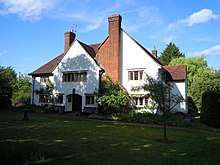Letchworth
Letchworth Garden City, commonly known as Letchworth, is a town in Hertfordshire, England, with a population of 33,600.[1] It is a former civil parish.[2]
| Letchworth | |
|---|---|
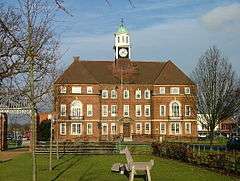 Letchworth Town Hall | |
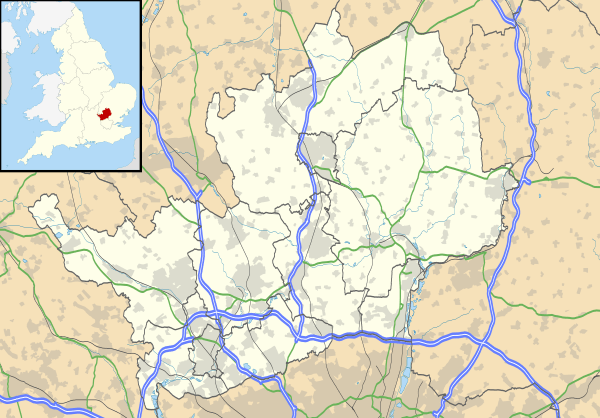 Letchworth Location within Hertfordshire | |
| Area | 7.767 sq mi (20.12 km2) |
| Population | 33,249 (2011 census) |
| • Density | 4,281/sq mi (1,653/km2) |
| OS grid reference | TL215325 |
| District | |
| Shire county | |
| Region | |
| Country | England |
| Sovereign state | United Kingdom |
| Post town | LETCHWORTH GARDEN CITY |
| Postcode district | SG6 |
| Dialling code | 01462 |
| Police | Hertfordshire |
| Fire | Hertfordshire |
| Ambulance | East of England |
| UK Parliament | |
The town's name is taken from one of the three villages it surrounded (the other two being Willian and Norton) – all of which featured in the Domesday Book. The land used was purchased by Quakers who had intended to farm the area and build a Quaker community. The town was laid out by Raymond Unwin as a demonstration of the principles established by Ebenezer Howard who sought to create an alternative to the industrial city by combining the best of town and country living. It is also home to the United Kingdom's first roundabout, which was built in 1909.[3]
As one of the world's first new towns and the first garden city it had great influence on future town planning and the New towns movement; it influenced Welwyn Garden City, which used a similar approach and inspired other projects around the world including the Australian capital Canberra, Hellerau in Germany, Tapanila in Finland and Mežaparks in Latvia.[4] There is a link to town planning in Stalingrad through the architect V. N. Semionov and an account of Lenin visiting the town when he visited England for a congress of the Russian Bolshevik party, then banned in Russia.[5][6]
Development
Before the Garden City: Old Letchworth
Letchworth was one of the ancient parishes of Hertfordshire. The parish church of St Mary the Virgin was built in the 12th or 13th Century.[7] The village was located along the road now called Letchworth Lane, stretching from St Mary's and the adjoining medieval manor house (now Letchworth Hall Hotel) up to the crossroads of Letchworth Lane, Hitchin Road, Baldock Road and Spring Road, where there was a post office. Letchworth was a relatively small parish, having a population in 1801 of 67, rising to 96 by 1901.[8]
The early days

In 1898, the social reformer Ebenezer Howard wrote a book entitled To-morrow: A Peaceful Path to Real Reform (later republished as Garden Cities of To-morrow), in which he advocated the construction of a new kind of town, summed up in his three magnets diagram as combining the advantages of cities and the countryside while eliminating their disadvantages. Industry would be kept separate from residential areas—such zoning was a new idea at the time—and trees and open spaces would prevail everywhere. His ideas were mocked in the press but struck a chord with many, especially members of the Arts and Crafts movement and the Quakers.
According to the book the term "garden city" derived from the image of a city being situated within a belt of open countryside (which would contribute significantly to food production for the population), and not, as is commonly cited, to a principle that every house in the city should have a garden.
The concept outlined in the book is not simply one of urban planning, but also included a system of community management. For example, the Garden City project would be financed through a system that Howard called "Rate-Rent", which combined financing for community services (rates) with a return for those who had invested in the development of the city (rent). The book also advocated a rudimentary form of competitive tendering, whereby the municipality would purchase services, such as water, fuel, waste disposal, etc., from (often local) commercial providers. These systems were never fully implemented, in Letchworth, Welwyn or their numerous imitators.
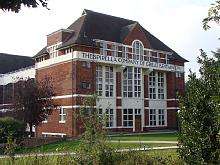
A competition was held to find a town design which could translate Howard's ideas into reality, and September 1903 the company "First Garden City Ltd." was formed, Richard Barry Parker and Raymond Unwin were appointed architects, and 6 square miles (16 km²) of land outside Hitchin were purchased for building. In keeping with the ideals only one tree was felled during the entire initial construction phase of the town, and an area devoted to agriculture surrounding the town was included in the plan – the first "Green Belt".
In 1905, and again in 1907, the company held the Cheap Cottages Exhibitions, contests to build inexpensive housing, which attracted some 60,000 visitors and had a significant effect on planning and urban design in the UK, pioneering and popularising such concepts as pre-fabrication, the use of new building materials, and front and back gardens. The exhibitions were sponsored by the Daily Mail, and their popularity was significant in the development of that newspaper's launching of the Ideal Home Exhibition (which has more recently become the Ideal Home Show) – the first of which took place the year after the second Cheap Cottages Exhibition. In 1907 the Meeting House 'Howgills' was built in the town for the Society of Friends.
A railway station was opened in 1903 a few hundred yards west of its current position and railway companies often ran excursions to the town, bringing people to marvel at the social experiment and sometimes to mock it: Letchworth's founding citizens, attracted by the promise of a better life, were often caricatured by outsiders as idealistic and otherworldly. John Betjeman in his poems Group Life: Letchworth and Huxley Hall painted Letchworth people as earnest health freaks.
One commonly-cited example of this is the ban, most unusual for a British town, on selling alcohol in public premises. This did not stop the town having a "pub" however – the Skittles Inn or the "pub with no beer" which opened as early as 1907.
Despite the ban it is not entirely true to say that there were no pubs in the Garden City. Pubs that had existed from before the foundation of the Garden City continued – including the Three Horseshoes in Norton, The George IV on the borders with Baldock, and the Three Horseshoes and The Fox in Willian – continued to operate (as they do to this day), and undoubtedly benefited from the lack of alcohol to be had in the centre of the town, as did the pubs in neighbouring Hitchin and Baldock. New inns also sprang up on the borders of the town, one such example being the Wilbury Hotel which was just outside the town's border.
This ban was finally lifted after a referendum in 1958, which resulted in the Broadway Hotel becoming the first public house in the centre of the Garden City. Several other pubs have opened since 1958, but to this day the town centre has fewer than half-a-dozen pubs – a remarkably low number of a town of its size. One effect of this is that the centre of the town is normally a noticeably quiet and peaceful place in the evenings.
One of the most prominent industries to arrive in the town in the early years was the manufacture of corsets: the Spirella Company began building a large factory in 1912, close to the middle of town and the railway station that opened the next year. The Spirella Building, completed in 1920, blends in despite its central position through being disguised as a large country house, complete with towers and a ballroom. During the Second World War, the factory was also involved in producing parachutes and decoding machinery. Because corsets fell out of fashion, the factory closed in the 1980s, and was eventually refurbished and converted into offices.
Another significant employer in the town was Shelvoke and Drewry, a manufacturer of dustcarts and fire engines which existed from 1922 until 1990; as was Hands (Letchworth), James Drewry joining them in 1935, who manufactured axles, brakes and Hands Trailers. Letchworth had a very diverse light industry, including Kryn & Lahy Steel Foundry, often a target for German bombers in World War II, the Irvine's Airchutes Parachute Factory, J. M. Dent and Son (also known as The Aldine Press, Garden City Press).
The biggest employer was British Tabulating Machine Company, later merging with Powers-Samas to become International Computers and Tabulators (ICT) and finally part of International Computers Limited (ICL). At one time the "Tab" as it was known had occupancy of over 30 factories in Icknield Way (the original pre-Roman Road), Works Road and finally in Blackhorse Road. Blackhorse Road was built on what was the continuation of the original Icknield Way. Upon building the new ICL building, evidence for extensive Neolithic and Iron Age occupation was found, the excavation being carried out by John Moss-Eccardt of Letchworth Museum & Art Gallery. Some of the artefacts are now on display in North Hertfordshire Museum, in Hitchin. In the Second World War, a number of early computers were built in what became known as the ICL 1.1 plant.
Civic history[9]
In addition to the usual local government bodies, Letchworth is unique in having a private charity responsible for the management of many aspects of the town (or the "Garden City estate") which has many planning and grant making functions normally associated with elected public authorities.
Local government
The civic local government of Letchworth has always been separate from the Company, Corporation or Foundation.
1908–1919: Letchworth Parish Council
Before the founding of the Garden City each of the three original villages – Letchworth, Norton and Willian – were within Hitchin Rural District. An unofficial "Residents' Union" or "Residents' Council" for the town was established in June 1905, meeting monthly until March or April 1908 when Letchworth (Civil) Parish Council was formed, within Hitchin RDC.
1919–1974: Letchworth Urban District Council
The Parish Council continued to meet in a relatively informal way until 1910 when the first council elections took place for 16 seats. In 1919 Letchworth Urban District Council (UDC) was formed, replacing the Parish Council, and taking over responsibility from Hitchin RDC for the local services – such as libraries, museums, parks and leisure – which were not the responsibility of the county council. 15 councillors were elected – nine "all party", four Labour, and two independent. Seats were hotly contested in the early years, but elections had lapsed into apathy by 1925. Although the council had no active role in town planning and building control until after 1945, it built nearly 5,000 homes in the town.
1974–present: North Hertfordshire District Council
Along with all other UDCs in England, the Letchworth UDC was abolished on 1 April 1974 by the Local Government Act 1972. Most of its responsibilities passed to the newly created North Hertfordshire District Council, though some became the responsibility of the county.
2006–2013: Letchworth Garden City Council
The new two-tier arrangement stayed in place until 2005 when, following a referendum, a parish council – which was named the Letchworth Garden City Town Council – was created. In the elections, all 24 being won by independents. However even before its formation the new body had had detractors, a situation that grew as the council began its work. Opponents of the council highlighted a number of decisions, including:
- In 2006/07 over 50% of its funding was spent on administrative overheads. In 2007/08 operational overheads consumed 80% of the council's precept in the council tax.[10] The town council was accused of claiming credit for the actions of others in a dispute on the Grange Estate.
- In August 2007 the town council's chairman, Philip Ross, adopted the title of mayor, as was the usual practice for a chairman of a town council. £11,000 was spent on his chain of office, including £9,975 for a new coat of arms for the new council.[11] Cllr. Ross agreed to a formal petition for arms to the College of Arms in March 2009. The incoming council, elected a few weeks later, were unaware of this application and – in the absence of any request to stop the process – the college issued the council's new arms in December 2010.
- By 2007 the Council had its fourth town clerk since its inception and councillors had been the subject of complaints to the Standards Board for England.
- Until 2008, despite a number of councillors resigning their posts, no further elections had been held. Councillors had instead relied upon their right to co-opt new members to vacant seats.[12][13]
- For 2008/09 the council increased its charge in the Council Tax by 206.7% to fund projects not included in the original election manifesto. This compared to a 4.5% increase by Hertfordshire County Council and North Hertfordshire District Council.[14]
- In April 2008, a poll in the town on the question 'Should Letchworth Garden City Council be dissolved?' resulted in over 76% of respondents voting in favour of its abolition; turnout was 15.6%.[15] A larger percentage were in favour of the abolition of the town council than had been in favour of its creation. In contrast, the town council's survey suggesting 54% of households who responded would prefer a single permissions scheme for planning applications is described by the town council as significant.
In September 2008, following the death of a sitting town councillor, the nomination of a member of the group seeking the dissolution of the town council ("HELP") was not opposed. Later in the year, when four town councillors resigned, HELP candidates were again nominated for the vacancies: opposing candidates were nominated and by-elections were held in the four wards concerned on 8 January 2009. All four "HELP" candidates were returned with significant majorities.[16][17][18][19]
In June 2009 all 24 seats on the council were contested by candidates representing HELP and the Town Council Supporters Party. 22 out of 24 seats were won by HELP.[20] The two seats won by the town council Supporters were won by margins of six and one votes. Among those to lose their seats was the chairman of the town council Philip Ross. The office of mayor was abolished by the incoming council chairman, George Ritchie, who remains to this day, the last mayor of Letchworth.[21] The new council quickly adopted a policy "to close down all Council activities as soon as legally and morally possible leading to a non-spending council so that its dissolution can then be sought". In December 2009 the Letchworth Community Democratic Association (mainly defeated councillors and recipients of council grants)[22] attempted to seek a judicial review of the legality of this policy, but this was thrown out by the high court.[23]
In December 2009, it was revealed that the previous council had precepted a total of £1,496,000 from the taxpayers of Letchworth and distributed grants totalling only £116,000.[24] Although it was subsequently stated that some £258,000 remained on account, with defeat at the election likely, the outgoing council had chosen to give its six staff such generous contracts that £200,000 of that reserve went to them, rather than giving any benefit for the Letchworth community.[25]
In May 2012 a consultation, asking all Letchworth residents what kind of local governance they wanted, resulted in 74% of respondents supporting the abolition of Letchworth Town Council. As a result, in July, North Hertfordshire District Council resolved that a second consultation took place to propose the abolition of Letchworth Town Council. This postal consultation was sent out on 24 August and ran for six weeks. In November it was announced that with a 25.88% turnout, there were 5,358 votes (75.06%) to abolish the council: with 1095 (15.34%) against (Don't Know: 685 (9.6%)). As a result, on 22 November 2012 District councillors voted unanimously to abolish the council. It was dissolved on 31 March 2013.[26]
Management of the Garden City estate
The current arrangements have evolved from one of Letchworth Garden City's founding principles which, unlike any other British attempt at new town design, was that land should be held in common for the good of all.
1903–1963: First Garden City Limited
From 1903 First Garden City Ltd owned the entire estate. The original idea was for the residents to purchase the estate after seven years so as to become responsible for the town, but "When the company was formed, however, this period of seven years was omitted.".[27] Until 1945 FGC Ltd, with the compliance of the District Councils, ran almost all aspects of life in the emerging town, leasing plots to citizens for building houses, to farmers for growing crops, and so on. The rents provided income for the company, which it would then invest back into the community. All citizens were shareholders, so all money was invested for the common good, and developments which the citizens disliked (tower blocks, for example) could be restricted as they pleased. This only began to change from 1945 when changes at the national level resulted in several of FGC's services (such as electricity and gas generation) being nationalised while the UDC took on a greater responsibility for planning.
The arrangements began to break down and many residents in the town would often remark about the town being run by the "forty thieves". In 1961 matters came to a head when Amy Rose and a company named Hotel York Ltd realised that if it bought enough of the shares from the citizens it could have a controlling interest in the town's estate, with no guarantee that the money would be used for the common good.
1963–1995: Letchworth Garden City Corporation
To remedy this, the then Member of Parliament, Martin Madden sponsored a bill in Parliament, and Parliament passed the Letchworth Garden City Act 1962, which created a public body, the Letchworth Garden City Corporation, to take on the business of First Garden City Ltd; as a statutory corporation it could not be bought. The Corporation's officers were appointed by the Crown and could level a supplementary rate, which for some years it did partly in order to pay Hotel York compensation.
The main task for the Corporation was to own and manage the 5,300-acre (21 km2) Garden City estate – including offices, factories, shops, houses, community amenities, farms and land. This included powers related to planning applications (which would normally be the preserve of the local council) in order to safeguard the character of the Garden City.
1995–present: Letchworth Garden City Heritage Foundation
By the 1990s the political tide had turned against "quangos" and it became policy of the then Conservative government to abolish them, wherever possible. As a result, in 1995 the Letchworth Garden City Heritage Foundation Act 1995 replaced the public sector corporation with the Letchworth Garden City Heritage Foundation – an "industrial and provident society" registered with the Registrar of Friendly Societies with "exempt charity" status.
The new Foundation retains most of the former Corporation's functions and responsibilities. Its published mission statement says that the Foundation exists "to create, maintain and promote a vibrant, quality environment in Letchworth Garden City, for all those who live, work and visit the world's first Garden City." It also aims to "maximise the financial returns from the assets we hold in trust and to re-invest those returns:
- To improve an increasingly valuable asset base; and
- To support charitable activities which meet demonstrable needs and provide a proven benefit to the community."
Although a private body – with a Chief Executive (currently Graham Fisher) and a team of Executive Directors – the Foundation also has a degree of democratic accountability with the Directors reporting to a Board of Management, which includes local authority representatives, plus six of the thirty Governors of the Heritage Foundation, who are elected to be representative of various groups in the town.
Many of the original ground leases were written to last for nine hundred and ninety-nine years, but some ran for only ninety-nine; around 2001 many of these shorter leases began to expire, whereupon the Foundation sold the freehold of the land to the house-owners.
Letchworth is thus in theory owned collectively by its residents, as opposed to landlords – although in fact, ownership resides in a trust. By holding most of the commercial buildings in the trust, the trust is able to raise income by leasing them out to shopkeepers. It has assets of over £127m. No dividend payments are made to the residents, but instead, the profit of £7m a year is invested into the local economy.
Letchworth today
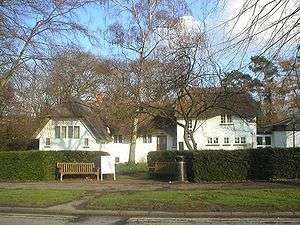
Several housing estates have been added to Letchworth since its inception.
To the north of the town The Grange began construction in 1947 and to the south east Jackmans[28] was built from 1961. These were council / municipal housing estates with many residents originally coming from the London overspill. Two more prosperous (and private) estates – Lordship and Manor Park – were built from in 1971 to the south west.
Smaller areas of in-fill housing also appeared in the 1990s, particularly on land adjacent to Jackmans Estate on the sites of a former creamery and the Willian Secondary School, which had closed in 1991 when school rolls in the town had begun to fall.
Willian School, along with two primary schools (Lannock and Radburn) had been built as part of the Jackmans Estate, which was constructed with not only its own schools, but also shops, library, community centre, sheltered housing, and public house. Bordered by major roads this almost self-contained community developed a reputation as being slightly cut off from the rest of the town and tends to be overlooked in most studies of Garden City development.
This is an unfortunate oversight as the plan of the estate (based on the "Radburn principle" pioneered in Radburn, New Jersey – a town whose design was itself inspired by the original Garden City) was an impressive and largely successful addition to the town, and matched most Garden City principles. Certainly for a period that has a reputation for poor town and residential planning it is remarkably well executed piece of urban design.
Almost all residential housing on Jackmans Estate is in a series of cul-de-sacs with access off a single feeder road – appropriately called Radburn Way – which in turn is crossed by a series of underpasses.
The effect is to largely separate pedestrians from motor traffic. Most houses do not open onto streets with passing traffic, but onto pedestrian squares, green areas, and children's playgrounds. The estate is crossed by a series of footpaths. The idea is not unique to Jackmans Estate, and has been tried in New Towns elsewhere, but rarely so successfully.
In some cases the housing itself varied in quality as – perhaps harking back to the Cheap Cottages Exhibition 60 years before – various different construction methods were tried, including the pre-fabrication of some houses at a shipyard in Sunderland. This resulted in dwellings with large amounts of internal space, but of variable build quality (particularly, it is alleged, for houses whose panels were constructed on Friday afternoons). Other parts of the estate used more traditional methods.
Over time increased mobility and changing age profiles has reduced the need for the estate to have its own facilities. Although a small parade of shops and a community centre flourish, the estate lost its secondary school (Willian) in 1988, its public house (initially called the Carousel, later the Gatehouse, finally the Sportsman) in 1998, and its public library in 2006. By 2007 the two primary schools on the estate were both running at under 50% capacity, and after a brief consultation the county council closed Lannock Primary School, the smaller of the two, in July 2009. Radburn Primary remains in operation.
The Garden City estate began to turn a profit in the 1970s, leading to investment in a number of town amenities: a working farm, Standalone Farm, in 1980, a leisure centre and a theatre named Plinston Hall in 1982, a free hospital (the Ernest Gardiner Day Hospital) in 1984, and major refurbishment of the town's cinema and shopping centre in 1996 and 1997. A further major programme to improve and update facilities in the town centre – entirely funded by the Foundation – began in 2009.
Letchworth was struck by an F1/T2 tornado on 23 November 1981, as part of the record-breaking nationwide tornado outbreak on that day.[29]
On 1 October 1995, the 'Foundation day' event took place celebrating the 100th anniversary of the establishment of Letchworth. Markets and stalls ran throughout the day, whilst a fun fair was erected in Norton Common, where tribute bands performed and a fireworks display was held. 'Foundation day' was shortly an annual event for around 5–6 years. The Foundation later celebrated the town's centenary in 2003 by building a landscaped path for walkers and cyclists. The path, known as the Greenway, forms a 20 km loop around the town.
In 2011 the first George Orwell Festival was held in Letchworth and Wallington, the nearby village where George Orwell lived from 1936 until 1940 and then intermittently until 1947. It was where he wrote some of his most famous books, essays, reviews, diaries and letters, and where he developed many of the ideas leading to his greatest two novels, Animal Farm and Nineteen Eighty-Four. There was a further festival in 2012.
Geography
Climate
Letchworth experiences an oceanic climate (Köppen climate classification Cfb) similar to almost all of the United Kingdom.[30]
| Month | Jan | Feb | Mar | Apr | May | Jun | Jul | Aug | Sep | Oct | Nov | Dec | Year |
|---|---|---|---|---|---|---|---|---|---|---|---|---|---|
| Average high oC[31] | 6.7 | 7.0 | 9.9 | 12.7 | 16.1 | 19.2 | 21.8 | 21.6 | 18.3 | 14.1 | 9.7 | 6.9 | 13.7 |
| Average low oC[31] | 1.2 | 1.0 | 2.7 | 4.0 | 6.9 | 9.8 | 11.9 | 11.8 | 9.9 | 7.1 | 3.8 | 1.6 | 6.0 |
| Average precipitation mm[31] | 67.0 | 47.7 | 49.1 | 54.1 | 52.0 | 52.7 | 48.8 | 62.5 | 57.2 | 81.1 | 75.0 | 65.1 | 712.3 |
| Average precipitation days (≥ 1.0 mm)[31] | 12.1 | 9.4 | 10.2 | 10.2 | 8.8 | 8.6 | 8.0 | 8.8 | 8.9 | 11.0 | 11.6 | 11.0 | 118.5 |
| Mean monthly sunshine hours[31] | 60.6 | 77.3 | 111.7 | 159.9 | 193.9 | 199.1 | 207.1 | 199.1 | 143.7 | 113.2 | 69.1 | 50.6 | 1585.3 |
The Garden City Greenway
The Greenway is a 13.6 miles (21.8 km) circular route that surrounds the Garden City estate. There are a variety of routes, open spaces and points of interest around the Greenway. Car parking at Radwell Meadows and Northfields Playing Field give access to disabled users and those with pushchairs as there are good sections of pathway way from these access points.
The Greenway received £1 million funding from the Heritage Foundation, to act as a permanent commemoration of Letchworth Garden City's first centenary in 2003.
Sport and leisure
Sport has played an important part in the town's history from the very beginning.
Cricket
A cricket field appeared on some of the very earliest plans for the town, and the town's Letchworth Garden City Cricket Club was established within two years of the foundation of the Garden City. Therefore, - although possibly not the first sports club in the town – it is probably the oldest still in existence.
Based for many years at Muddy Lane, the club moved to the former ICL sports field in Whitethorn Lane in 1996, a move that has allowed it to expand its junior section significantly to the extent that the club now has one of the largest and most successful junior cricket sections in the county. This in turn has been recognised by the club being one of very few clubs in Hertfordshire to be named an ECB "Community Focus Club", following on its Clubmark accreditation (which recognises sports clubs who exhibit excellence in club organisation and have active policies relating to Equity, Child Welfare and Safety). There are five men's teams which all compete in leagues.
The growth of the club resulted in the opening of a second ground in 2006 – the restored former Fairfield Hospital cricket ground in nearby Arlesey. The club is also the home of a Women's and Girls' section, originally formed in 1985 as part of Hitchin Cricket Club (though for the first two years its home games were at Knights Templar School in Baldock). Jackie Lansdown, the club's founder, persuaded several international cricketers to play for the team in its first few years – including Avril Starling, Megan Lear, and Gill McConway. The promise of improved facilities and support resulted in the team moving to Letchworth in 2004.
Athletics
Road running
North Herts Road Runners are also based at the Spirella Building where it meets on Tuesday and Thursdays. Athletes are of all abilities, from occasional jogger to county class runners. The club competes in a winter cross-league which it has won on many occasions and a summer road race league as well as the Standalone 10k.[32]
Triathlon
Freedom Tri is the only triathlon club based in Letchworth and was formed in 2009.
Hockey
Another club based at Whitethorn Lane is Letchworth Hockey Club which runs Eleven adult teams – Six Men's and Five Women's XIs. In season 2004/2005 the Ladies 1st XI joined the Women's National Premier League for the first time in our Club's history. Despite getting relegated Letchworth Ladies have successfully raised the profile of our club and shown they can compete with the best clubs in the country. The Men's section (currently in 2018/19 Season) have their 1st XI in the East Leagues Premier A Division. There is also a flourishing Mini's section of the Club for both Boys and Girls in varying age groups from U8's to U18's.
Roller hockey
The leisure centre is also the home of Letchworth Roller Hockey Club which was for many years one of the strongest clubs in the country. Their latest success coming when their senior team became national division 1 champions in the 08/09 season.
Bowls
However, the oldest club based at Whitethorn Lane is Whitethorn Bowls Club – but it is only one of several bowls clubs based in the town.
The oldest of these is Norton Bowls Club, established in 1908. Their first recorded match was a 70-50 point win over Walsworth BC on Saturday 22 August 1908, (although they lost the return match four days later by 86-40). Norton was involved in the formation of the North Herts Bowls League (1909), Hertfordshire Bowls Association (1920), and the Letchworth & District Bowls Association (1944).
Other bowls clubs in the town include Letchworth Garden City BC and Willian BC (both based on Norton Common), and Howard Garden (on Norton Way South).
Tennis, squash and croquet
After a short period as a football ground, the Cricket and Hockey club's former ground in Muddy Lane is now the home of Letchworth Tennis Club which had previously been hidden away on Paddock Close.
Selling its old home for housing allowed the club to develop Muddy Lane into what is one of region's largest and most state-of-the-art tennis venues, which has in turn led to an explosion in membership as well as a number of awards from district and county sporting organisations.
The tennis club facility also offers squash, gym and croquet, being the home of Letchworth Croquet Club.
Croquet
Letchworth Croquet Club is based at Letchworth Sports and Tennis Club in Muddy Lane. Letchworth Garden City Croquet Club was founded in 1987 by a small group of enthusiasts and with the help of the (then) corporation were provided with a venue for their activities on the site of the old Spirella tennis courts adjacent to Willian Way. After much work on the playing surface, including using the ancient heavy roller left behind after the demise of the Spirella Sports Ground two nearly full-sized croquet lawns were created and the club members set about learning the finer points of the game with plenty of assistance from the East Anglian Croquet Association. Very surprisingly, after only two years the club won the Longman Cup, the premier national handicap competition; something that the majority of croquet clubs never achieve! The club moved to Muddy Lane to become part of Letchworth Sports and Tennis Club in Spring 2006. A special event was held with lunch and AC and GC tournaments. Dr Ian Vincent, Chairman of the Croquet Association, officially opened the lawns by running the first hoop. Since moving the club's membership has risen to over 70 people with a wide age range. The club is active in regional and national events and each year hosts the national final of the Croquets Association's Inter Club Golf Croquet Championship. The croquet lawns at Letchworth were constructed with assistance from the Sports Turf Research Institute and were laser levelled and 76 tons of Leighton Buzzard washed sand ameliorated into the top surface. In the ensuing years the club has conducted a rigorous lawn maintenance regime with the result that the two lawns are now amongst the finest in the UK.
Golf
The "Family Golf Centre" at Willian Way is one of two facilities for the sport within the town. For the more serious golfer Letchworth Golf Club offers a full 18 hole course, designed by Harry Vardon in 1911 but based upon a small nine-hole course first laid out as early as 1905. Vardon's course was, however, considered to be a little short for modern purposes and work began to extend the course in 1999, the new 6,459-yard (5,906 m) par-71 course being opened in 2003.
Swimming
Swimming also had an early start in the town – the first outdoor pool opening in 1908. However this rather basic original amenity (it was filled from the waters of Pix Brook and apparently grew murkier and murkier as the summer went on) was replaced by a state-of-the-art "Lido" on Norton Common in 1935.
This coincided with – or was perhaps the main driver for – the introduction of competitive swimming in the town with the formation of Letchworth Amateur Swimming Club in June 1932. Today it provides teaching and competitive swimming for children up to the age of 19, run by Head Coach Alan Tomlin.
The Club continues to use the outdoor pool – described by the Times Newspaper in 2004 as "Possibly the best open air pool in the area" - throughout the spring and summer. As well as a 50 m six lane main pool with a large trainer pool alongside, the facility includes an extensive sun bathing area, and free parking. Unfortunately increasingly stringent health and safety regulations have resulted in the disappearance of the original diving boards and slides.
During the winter months the club uses the public indoor pool which was opened as part of the North Herts Leisure Centre in the early 1980s, although as a leisure pool it is unsuitable for competitive galas. The indoor pool, previously owned by the council, has recently been taken over by Stevenage Leisure Ltd.
Two other pools in the town – at the two independent schools – are also widely used by the community, including the Letchworth Adult Swimming Club, though this is also predominantly a teaching club.
Recreation routes
The Icknield Way Path passes through the Town on its 110-mile journey from Ivinghoe Beacon in Buckinghamshire to Knettishall Heath in Suffolk. The Icknield Way Trail, a multi-user route for walkers, horse riders and off-road cyclists also passes through the Town.
Rugby union
Letchworth Rugby Club has also been an important part of the town's sporting life for over half a century, and is one of the oldest (and highest ranked) rugby clubs in the county, being formed in 1926.
Football
One sport that has had a remarkably difficult history (considering its national popularity) is association football. Letchworth's main semi-professional club – Letchworth F.C. (the "Bluebirds") – went out of business in 2002, only a few years after reforming following Letchworth Garden City FC's financial problems, but nearly a century of struggle and repeated name changes. The eventual demise of the club was not unconnected with the club's home ground becoming Hertfordshire FA's headquarters in 2000.
The first club to represent the town – Garden City FC began playing in 1906. It lasted barely a season under this name before reconstituting itself (for reasons unknown) as Letchworth Athletic, under which name it gradually worked it way through county and regional amateur leagues before becoming Athenian League champions in 1975.
The following year another name change saw the club become Letchworth Garden City, a move which unfortunately coincided with a gradual decline for the town's team down the divisions, resulting in financial problems, a brief re-invention, and then eventual closure in 2002. When Baldock Town closed in the same year the only senior league team in whole of North Hertfordshire was now Hitchin Town, which for the "national sport" might be considered quite unusual.
However, by 2008 a reformed Baldock Town had moved through the local leagues to reach the Premier Division of the Herts Senior County League. A search for a ground appropriate to their new status lead them to the County Ground in Letchworth, where they moved in August 2008 at the same time adopting the new name Baldock Town Letchworth F.C. (BTLFC).
This development coincided with the formation of a new adult team at Letchworth Garden City Eagles – which began its first season one division below BTLFC, but won promotion to join them in the Premier Division for the 2010/11 season. The club plays at Pixmore. next door to the County Ground. The two clubs meet in the first competitive "Letchworth Derby" on 20 March 2010 – Eagles winning the Aubrey Cup quarter final 2-1 – and there were three more "Letchworth derbies" in the 2010-11 season, all of which were also won by the Eagles. These were the last "derbies" - at the end of the season BTLFC announced that they were returning to Baldock, and reverting to their former name.
The adult Eagles team grew out of the junior Letchworth Garden City Eagles, The club was established in 1979 when it was known as Westbury United. The name was subsequently changed to Letchworth Garden City Eagles and by 2010 the club has expanded to over 450 registered players between the ages of 6 and 18, boys and girls. The two adult teams were formed to provide an exit route for youth players. They compete in the Herts Senior County League. The boys and girls teams play mini soccer and full size. The club attracts good sponsorship and regularly picks up trophies. Letchworth Garden City Eagles also now runs an adult ladies team.
Letchworth is also home to a thriving Sunday league football culture, which makes use of Letchworth's many green areas and recreational playing fields.
Powerlifting & weightlifting
The sport of Powerlifting and the activity of weight training have had a strong presence in the town with the IPF East Midland's Powerlifting Championship being regularly held at the Hitchin & Letchworth Weightlifting Club. The club was founded in 1966 as the Hitchin Weightlifting Club and was originally part of the Hitchin Youth Trust occupying a building at the Codicote Centre, Highbury Road, Hitchin. When the Trust decided that they would sell the site the club was asked to find another venue.[33]
It moved to a new and larger building at the Letchworth Corner Sports Club, Whitethorn Lane, Letchworth in October 2001.[34] The club name was changed to the Hitchin and Letchworth Weightlifting Club to reflect its history, location and membership. Over the years well over fifty lifters have competed for the club in Powerlifting, All Round Weightlifting, and in the 1970s bodybuilding competitions. The club has produced many county, divisional, national, and international champions.[35]
Other leisure activities
Astronomy
The Letchworth & District Astronomical Society society meets at the Elizabeth Howard Memorial Hall in the centre of the town. Prior to 2010 they met at Plinston Hall for about 20 years, but outgrew the venue as the membership increased to over 90. This was primarily a result of their activities during the International Year of Astronomy in 2009, when they had the largest programme of activities of any society in the UK.
Cinema
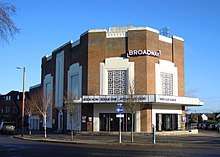
On 12 July 1996 the 1936 art deco Broadway Cinema situated in the town centre was reopened, continuing the rich tradition of local cinema. In 1909, the first cinema outside London, the Palace Cinema, opened in Letchworth. The Palace was refurbished in 1924. Six years later, on a site a few yards away, the Broadway Cinema was created. The cinema opened on 26 August 1936 with a black tie gala screening of Follow the Fleet starring Fred Astaire and Ginger Rogers.
The Palace Cinema in Letchworth closed on 31 December 1977. The Broadway Cinema closed temporarily at the end of February 1996 with a special screening of Windbag the Sailor starring Will Hay.
To ensure the continued prosperity of the Broadway, the sixty shareholders of The Letchworth Palace Ltd had come together with the Letchworth Garden City Heritage Foundation in a £2m programme to revitalise the cinema from a single to a triple screen facility to combine the latest in sound, seating and projection with the original exterior and luxurious art deco interior features.
In 2009 the Letchworth Garden City Heritage Foundation took 100% control of the Broadway Cinema and as such allowed the building to become a 4 screen cinema; they also funded the refurbishment of Screen 1 and the inclusion of a new concession stand on the first floor as well as new and improved access facilities for disabled patrons.
In 2010, under a new management structure, the Broadway Cinema adapted its main screen and one other smaller screen to become 3D enabled. It also refurbished the 2 remaining auditoriums, offering comfortable seating in each of its 4 screens. In addition to showing some of the latest blockbusters, the cinema also screens live (as well as delayed or recorded) broadcasts from the Royal Opera House and the Royal National Theatre.
The Broadway Cinema appears in the 2013 film The World's End, as a fictional pub named The Mermaid.
Town twinning
Letchworth is twinned with:
Schools
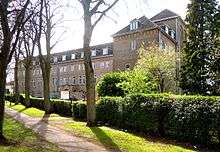
Letchworth hosts a mixture of both private and state schools. State secondary schools are The Highfield School, a Specialist Science Status school, and Fearnhill School, a Maths and Computing College. Fearnhill had formerly been the town's Grammar School until it became a comprehensive school in 1974. Letchworth Grammar School had originally occupied prominent buildings in the centre of the town which are now used by various local authority services, but which are still known as the 'Grammar School buildings' and which still displays the former school's name over its doors. These buildings housed the Da Vinci Studio School, Letchworth which opened in September 2013 and relocated to the Grammar School buildings in the Autumn of 2014. The school closed in 2017.[36]
The private schools in Letchworth are St Christopher School and single-sex girls' school St. Francis' College. St. Christopher School is arguably the most famous school in Letchworth, it is vegetarian and has a strong Quaker ethos. It originally occupied the St Francis College site where some of its original buildings remain, one of which displays a foundation stone bearing the name of Annie Besant and including some of the "open air" classrooms which remain in use to this day (albeit adapted slightly). Both schools admit both boarders and day-pupils.
The Knights Templar School is another local school. Although in the neighbouring town of Baldock, many children from Letchworth are taught there, especially following the closure of Norton School in 2002 which, for its final year of operation was called 'Knights Templar (Letchworth)'. Teacher shortages at the school had led to significant numbers of temporary staff, with the quality of teaching by some staff deemed unsatisfactory by an Ofsted report. It was the second of Letchworth's original four secondary schools to close, following the former Willian School which closed in 1991.
Black squirrels and other wildlife
Letchworth Garden City is home to one of the UK's largest colonies of black squirrels, thought by some to be a genetic mutation of the common North American Grey squirrel, but in fact a rare but not unique example of Melanism. Sightings of black squirrels originally appeared in the area of Norton Common and later the centre of the town from the 1950s, and possibly before, and have since gradually spread, becoming common on the Jackmans estate by the 1980s and Lordship in the 1990s. Now regularly spotted around the Town and in the numerous green spaces they are reasonably common in places like the Golf Club and Norton Common. Reports of black squirrels in the neighbouring town of Hitchin started to appear in the local press around 2005.
There are also muntjac deer living principally on Norton Common, but also increasingly elsewhere in the town (Jackman's Estate, for example where they often leave evidence of their presence on the allotments, much to the annoyance of allotment holders!). About the size of a large dog, they also find their way to domestic gardens and have been seen occasionally in the town centre. They can be something of a traffic hazard, especially on winter evenings, as they do not readily move out of the way of cars.
Roundabouts and Green Belts: Letchworth and 20th century urban design
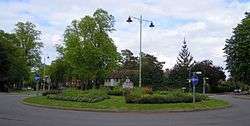
In 2007 architectural writer and broadcaster Jonathan Meades devoted a programme in his series Jonathan Meades Abroad Again to Letchworth. In "Heaven: Folkwoven in England" Meades suggested that many of the main features of British urban design in the twentieth century owed their origins to Letchworth Garden City - "a social experiment on a par with the Welfare State, a social experiment that affected us all and still does."
Meades's thesis was not entirely complimentary ("its legacy is Britain's ubiquitous, banal sprawl") but it is a theme that other writers have supported. Many factors underlying British housing design, and also town planning, began in Letchworth. The popularity of Parker and Unwin's "country" style, plus the success of the Cheap Cottages Exhibitions of 1905 and 1907, inspired British urban architectural design for many decades – a style which, according to Meades "shunned urbanism to an extent otherwise unknown on this continent".
However, innovation in Letchworth was not confined to the design of buildings. During January 2005 "Sollershott Circus" (to give it its formal name) in Letchworth Garden City was recognised as having the first roundabout on a public road in the United Kingdom, dating from circa 1909 (there are two signs on the roundabout saying "UK's First Roundabout Built circa 1909"). This was probably inspired by the traffic system at the Arc de Triomphe in Paris, a city which was familiar to Parker and Unwin.
When first built traffic could circulate around the central island in both directions. The more familiar rules of the road for roundabouts were not adopted until the 1920s. Roundabouts remain a feature of the Garden City's road network, which has only two sets of true traffic lights (discounting those on pedestrian crossings).
In addition the town was also the birthplace of the "Green Belt", certainly in its modern form of an area of land surrounding a town, designed to constrain its outward expansion. It was an important feature of Howard's concept – he saw a Garden City as having a maximum population of 32,000. The Green Belt also aimed to make the Garden City self-sufficient in food and agricultural products. In addition Letchworth was also intended to be self-sufficient in gas, water and electrical power – an aim it achieved, exporting power to neighbouring towns and villages until the late 1940s when power and gas generation were nationalised. The originally coal-powered electricity station was first converted to gas power in the last quarter of the 20th century before eventually being decommissioned and demolished in the early years of the 21st century.
In 2019 consultations are ongoing where the local council are seeking to expand Letchworth by building on greenbelt land against the original principles of the Garden City.
Industry
Electricity generation
Letchworth village had two adjacent electricity generating stations known as Letchworth A and B which were built in the 1920s and 1930s. Both were coal-fired and used chain grate boiler stokers. The buildings were in redbrick with a single brick chimney.[37]
Letchworth A had a rated output of 8 megawatts (MW) and its oldest equipment was installed in 1930.[38] The boiler delivered 115,000 lb/hr (14.5 kg/s) of steam at a pressure of 200 psi and 354 °C.[39] By the 1960s the A station was generating less than 8 GWh per year of electricity, it was decommissioned in 1968. Letchworth B had a higher rated output of 13 MW and its oldest equipment was installed in 1942.[38] The boiler delivered 160,000 lb/hr (20.2 kg/s) of steam at a higher pressure of 300 psi and 454 °C.[39] The B station was decommissioned on 18 March 1974. Both stations used cooling towers to condense steam.[39] The electrical output in GWh from the B station over the period 1961 to 1973 was as follows:[39][40]
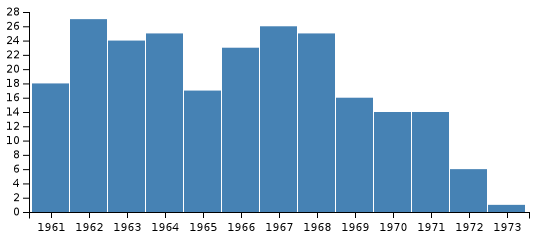
After the coal-fired stations were decommissioned a new gas turbine power station was built. This was located adjacent to the railway and had two reinforced concrete chimneys.[41] The station had two 70 MW gas turbines, giving a total generating capacity of 140 MW.[39] The first turbine was commissioned in May 1978. The generating capacity of the gas turbine station in GWh was as shown:[39]

The high output for the year ending 31 March 1985 is in the context of the UK 1984-5 miners’ strike.
The gas turbine power station has since been decommissioned and demolished.[41]
Notable residents
- John Allison - comic writer
- Jennie Bond – journalist at the BBC. She went to St Francis College and lived in Spring Road with her parents.
- Edward Carpenter – philosopher
- Samir Badre Carruthers is a footballer who plays as a winger for Milton Keynes Dons, and is a Republic of Ireland under-21 international.
- Bernard George Ellis, winner of the George Cross
- Adrian Fortescue - RC priest and scholar who founded the Church of St Hugh of Lincoln in the town. He is buried in Letchworth Cemetery.
- William Henry Gaunt - English transport engineer, buried in Letchworth Cemetery.
- A. A. Gill – writer and critic. Gill was educated at the progressive independent St Christopher School and would later recall his experiences at the school for his books The Angry Island and "Pour Me - A Life".
- Harold Gilman – artist, founder member of the Camden Town Group. Lived at 100 Wilbury Road.
- Spencer Gore – artist, first president of the Camden Town Group. Lived in Gilman's house (100 Wilbury Road) after Gilman had left it.
- George Harris – actor who had roles in Harry Potter films, Black Hawk Down and many others
- W. F. Harvey - horror writer. Died in Letchworth and was buried at St Mary's Church.
- Jack Hobbs – international cricketer. Holder of world record for most centuries – played for Letchworth after his retirement from first class cricket
- Shaun Hutson – horror author[42]
- Annie Kenney – suffragette, lived in Letchworth for some years before her death in 1953[43]
- Tom Killick – international cricketer, and rector of Willian[44]
- Dave Kitson – footballer[45]
- James Lovelock – scientist, author of the Gaia Theory, born in Letchworth[46]
- James Mayhew – writer and illustrator of children's books[47]
- John W. Mills - British sculptor
- Herbert Morrison – as a conscientious objector, he worked in a market garden in Letchworth in World War One where he met his wife, a handweaver and embroiderer.
- Frank Newman Turner – a pioneer in organic horticulture who moved here in 1958 and set up a practice in osteopathy, naturopathy and medical herbalism
- Laurence Olivier (Lord Olivier) – actor. Olivier's father was Rector of Letchworth Parish 1918–1924[48]
- William Ratcliffe – artist and member of the Camden Town Group
- Claire Rushbrook – actor
- John Martin Scripps – serial killer who was born in the town
- Jane Short - suffragette and activist for women's rights
- Morgan Simpson - drummer in the experimental rock band black midi.
- Philip Snow – author, cricketer, Assistant Colonial Secretary of the Fiji Islands [49]
- Sgt Frederick Tees – one of the original Dambusters of 617 Squadron who was the sole survivor from his bomber. His plane was shot down when he was the rear gunner; he survived and was a POW. He ran a barber's shop in Station Road later in life.[50]
- Carroll Thompson – lovers rock singer.
- Peter Underwood – parapsychologist and author, born in Letchworth[51]
- Paul Van Carter - film producer, produced Churchill.[52]
- Simon West – film director, directed Con Air[53]
- Josephine Wiggs – bass guitar player of The Breeders[54]
- Richard Wiggs – founder of The Anti-Concorde Project
- Michael Winner – film director, restaurant critic. Attended St Christopher School[55][56]
Archaeology
To the west of the town are the remains of Wilbury Hill Camp a Late Bronze Age hill fort. It comprises two adjacent enclosures and lies close by the Icknield Way. Settlement is understood to have started in the late Bronze Age, 700BC and it was further developed during the Iron Age. There is also evidence of continued occupation during the period of the Roman colonisation.[57] Regular digs are conducted by Norton Community Archaeology Group in the fields between Norton village and the A1, where they have found evidence of Bronze Age, Romano-British and late Iron Age settlement.
Letchworth in popular culture
Literature
- "The Lion and the Unicorn" In his polemic essay on wartime Britain, George Orwell said "The place to look for the gems of the future England is in light-industry areas and along the arterial roads. In Slough, Dagenham, Barnet, Letchworth, Hayes – everywhere, indeed, on the outskirts of great towns – the old pattern is gradually changing into something new". In The Road to Wigan Pier, chapter 11, he describes "two dreadful-looking old men", supposedly socialists, getting on a bus in Letchworth.
- So Long, and Thanks for All the Fish In the fourth book of The Hitchhiker's Guide to the Galaxy series, Ford Prefect complains about the difficulty of persuading telephone operators that he is calling from Letchworth when tapping into the British phone system from the Pleiades. Remarkably a new coat of arms, issued for the Garden City Council in December 2010, includes a motto (Share, Enjoy, Prosper) that is almost exactly the same as The Hitchhiker's Guide to the Galaxy's "Sirius Cybernetics Corporation Complaints division" (Share and Enjoy).
- Bigipedia (Series 1, episode 2) included reference to the "Letchworth Dog" - a fictional legend about a mysterious animal supposedly seen in the town in 1908.
The World's End (2013)
The film, The World's End, directed by Edgar Wright and starring Simon Pegg and Nick Frost, was filmed between September and December 2012 throughout Letchworth.
| Placename | Appears as |
|---|---|
| Wendy's Shop, Leys Avenue | The Good Companions [58] |
| The Three Magnets pub, Leys Avenue | The Trusty Servant [58] |
| The Platform pub, Eastcheap | The Two Headed Dog [58] |
| Broadway Cinema | The Mermaid [59][60] |
| Thai Garden Restaurant | The Beehive [58] |
| The Arena Tavern, Arena Parade | The King's Head[61] |
| Letchworth Railway Station | The Hole in the Wall[62] |
| The Gardner's Arms, now The Wilbury | The World's End |
See also
- The Cloisters Letchworth
- St George's Church
- Church of St Paul, Letchworth
- Letchworth Cemetery
References
- "Archived copy". Archived from the original on 29 April 2012. Retrieved 21 July 2012.CS1 maint: archived copy as title (link)
- The North Hertfordshire District Council (Reorganisation of Community Governance) Order 2013
- "Roundabouts: The widening gyre". The Economist. 3 October 2013. Retrieved 11 April 2017.
- "Archived copy" (PDF). Archived from the original (PDF) on 11 February 2017. Retrieved 29 October 2019.CS1 maint: archived copy as title (link)
- "Archived copy". Archived from the original on 23 January 2015. Retrieved 11 May 2014.CS1 maint: archived copy as title (link)
- "Lenin in Letchworth, Letchworth Garden City Heritage Foundation". Letchworth.com. 20 March 2013. Archived from the original on 12 May 2014. Retrieved 11 April 2017.
- Historic England (27 May 1954). "PARISH CHURCH OF ST MARY (1347697)". National Heritage List for England. Retrieved 11 April 2017.
- "Letchworth AP/CP through time | Census tables with data for the Parish-level Unit". Visionofbritain.org.uk. Retrieved 11 April 2017.
- Much of the information in this section is derived from An outline history of governance of Letchworth Garden City by John Webb and published by Letchworth Garden City Council in 2006
- "Help Eliminate Letchworth Parish council". Helpletchworth.co.uk. 21 April 2008. Retrieved 11 April 2017.
- Council Tax Bill issued by NHDC for a Band C property in Letchworth Garden City, 14 March 2008
- "Archived copy". Archived from the original on 16 July 2011. Retrieved 30 July 2008.CS1 maint: archived copy as title (link)
- "Archived copy". Archived from the original on 16 July 2011. Retrieved 6 June 2009.CS1 maint: archived copy as title (link)
- "Abolition of mayor, 2009".
- Archived 7 September 2007 at the Wayback Machine
- "Judge throws out attempt for review of Letchworth Garden City Council affairs - News". The Comet. Retrieved 11 April 2017.
- "Archived copy" (PDF). Archived from the original (PDF) on 9 October 2011. Retrieved 31 October 2011.CS1 maint: archived copy as title (link)
- "Hertford News, Sport & What's On in Hertford | Hertfordshire Mercury". Theadvertisergroup.co.uk. Retrieved 11 April 2017.
- Nick Gill. "Unanimous vote for Letchworth town council abolition - News". The Comet. Retrieved 11 April 2017.
- CB Purdom (1963) The Letchworth Achievement … London: JM Dent & Sons Ltd.
- "Archived copy". Archived from the original on 30 September 2007. Retrieved 10 March 2007.CS1 maint: archived copy as title (link)
- http://www.eswd.eu/cgi-bin/eswd.cgi
- "Records and Averages". Msn.com. 8 February 2017. Retrieved 11 April 2017.
- Office, Met. "Letchworth climate". www.metoffice.gov.uk. Retrieved 6 November 2017.
- "North Herts Road Runners". North Herts Road Runners. Retrieved 6 November 2017.
- "Main". ~facebook.com/HitchinAndLetchworthWeightliftingClub. Retrieved 15 November 2019.
- "Main". ~letchworthsports.com. Retrieved 19 March 2017.
- "Main". ~Hitchinandletchworthweightliftingclub.org.uk. Retrieved 19 March 2017.
- "Da Vinci's going down– inventive education idea runs its course and North Herts studio schools will shut next year - Comet life". The Comet. Retrieved 11 April 2017.
- "Letchworth Village Power Plant". All Abandoned. Retrieved 1 February 2020.
- "British Power Stations operating at 31 December 1961". Electrical Review. 1 June 1962: 931.
- CEGB Statistical Yearbook (Various years). CEGB, London.
- CEGB Annual Report and Accounts, various years
- "Letchworth power station". Geograph. Retrieved 1 February 2020.
- "Shaun's Shit 2000". Web.archive.org. Archived from the original on 4 May 2010. Retrieved 11 April 2017.CS1 maint: BOT: original-url status unknown (link)
- "Archived copy". Archived from the original on 17 September 2011. Retrieved 25 July 2011.CS1 maint: archived copy as title (link)
- "Tom Killick | Cricket Players and Officials". ESPN Cricinfo. Retrieved 11 April 2017.
- Ley, John (14 March 2005). "Kitson puts Pardew future in balance". Telegraph. Retrieved 11 April 2017.
- "Lovelock: Curriculum Vitae". Jameslovelock.org. 26 July 1919. Retrieved 11 April 2017.
- "Beds Herts and Bucks - Entertainment - Chapter and verse on James". BBC. Retrieved 11 April 2017.
- "Archived copy". Archived from the original on 19 December 2010. Retrieved 24 July 2011.CS1 maint: archived copy as title (link)
- Mercury, Leicester (28 March 2012). "Cricketer and Fiji diplomat is honoured | Leicester Mercury". Thisisleicestershire.co.uk. Archived from the original on 8 November 2012. Retrieved 11 April 2017.
- "Archived copy" (PDF). Archived from the original (PDF) on 6 December 2010. Retrieved 16 February 2013.CS1 maint: archived copy as title (link)
- "Archived copy". Archived from the original on 16 November 2011. Retrieved 25 July 2011.CS1 maint: archived copy as title (link)
- https://www.imdb.com/name/nm1794018/
- "Archived copy". Archived from the original on 16 April 2010. Retrieved 8 July 2011.CS1 maint: archived copy as title (link)
- Larkin, Colin (1998) The Virgin Encyclopedia of Indie & New Wave, Virgin Books, ISBN 0-7535-0231-3, p. 318
- "UK | Magazine | Faces of the week". BBC News. 29 April 2005. Retrieved 11 April 2017.
- Ciaran Brown (21 January 2013). "Ciaran Brown meets Michael Winner". Ciaranbrown.com. Retrieved 11 April 2017.
- "Wilbury Hill Hillfort – The Modern Antiquarian.com". Themodernantiquarian.com. Retrieved 11 April 2017.
- "Archived copy". Archived from the original on 8 July 2013. Retrieved 8 July 2013.CS1 maint: archived copy as title (link)
- Craig White [@whitecraig] (21 November 2012). "Film set for #theworldsend The Broadway Cinema, Letchworth. Now it's The Mermaid. @simonpegg @nickjfrost" (Tweet) – via Twitter.
- Kim Barratt [@KimBarratt] (23 November 2012). "Broadway Cinema undergoes transformation to become The Mermaid pub for #theworldsend film set" (Tweet) – via Twitter.
External links
| Wikimedia Commons has media related to Letchworth Garden City. |
